Business Finance Report: Cash Flow, Budgeting, and Working Capital
VerifiedAdded on 2023/01/18
|12
|3427
|29
Report
AI Summary
This report analyzes key aspects of business finance, focusing on cash flow, budgeting, and working capital management. Part 1 examines the relationship between profit and cash flow, highlighting their differences and the impact of working capital on cash flow. It includes an analysis of cash flow statements and recommends strategies for improving cash flow through effective working capital management, such as optimizing inventory, managing receivables and payables, and considering long-term financing. Part 2 explores budgeting techniques, comparing traditional and alternative methods like rolling and zero-based budgets. The report evaluates the purpose of budgeting, describes the application of these methods, and assesses the suitability of alternative versus traditional budgetary systems for BoatWorld Plc. The report emphasizes the importance of these financial tools for business performance and decision-making.
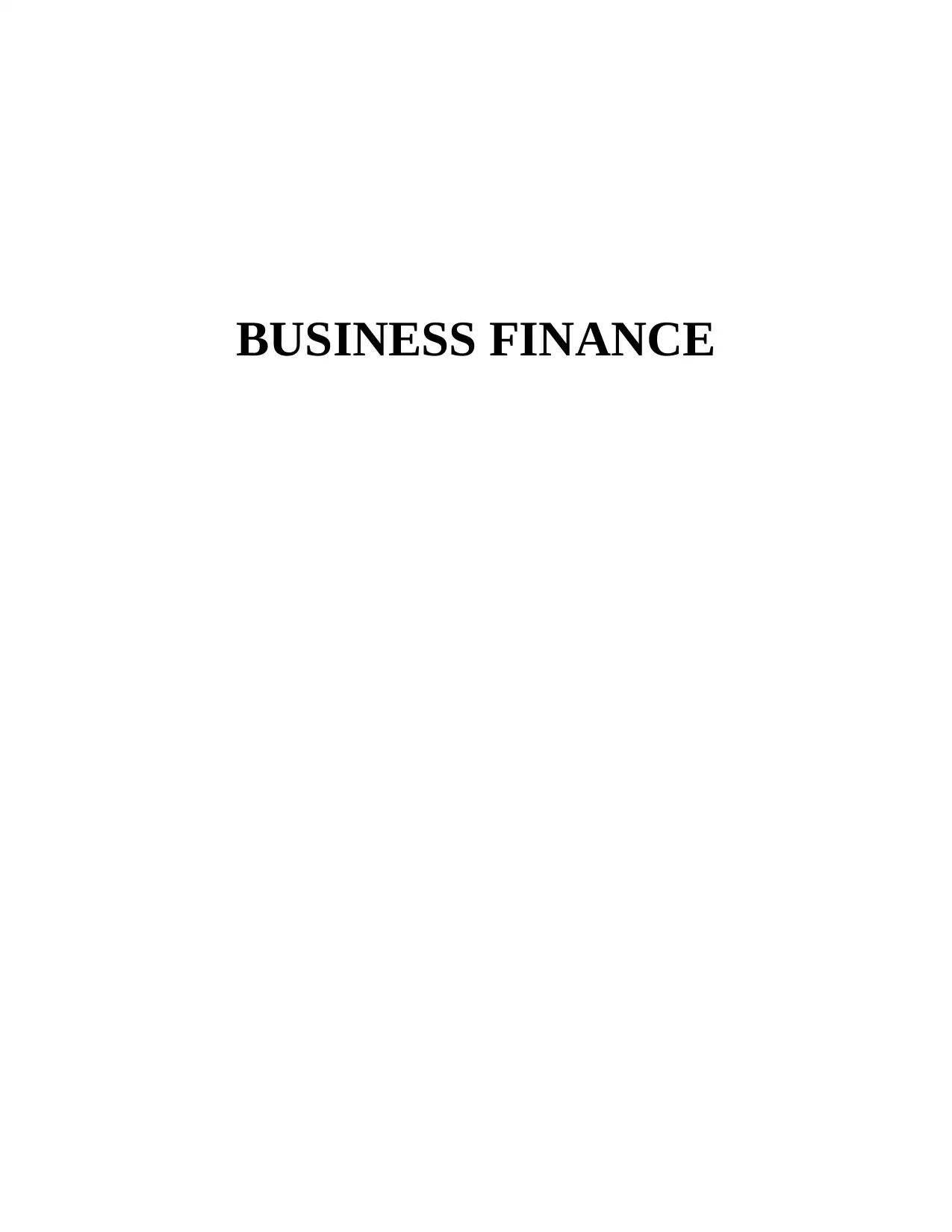
BUSINESS FINANCE
Paraphrase This Document
Need a fresh take? Get an instant paraphrase of this document with our AI Paraphraser
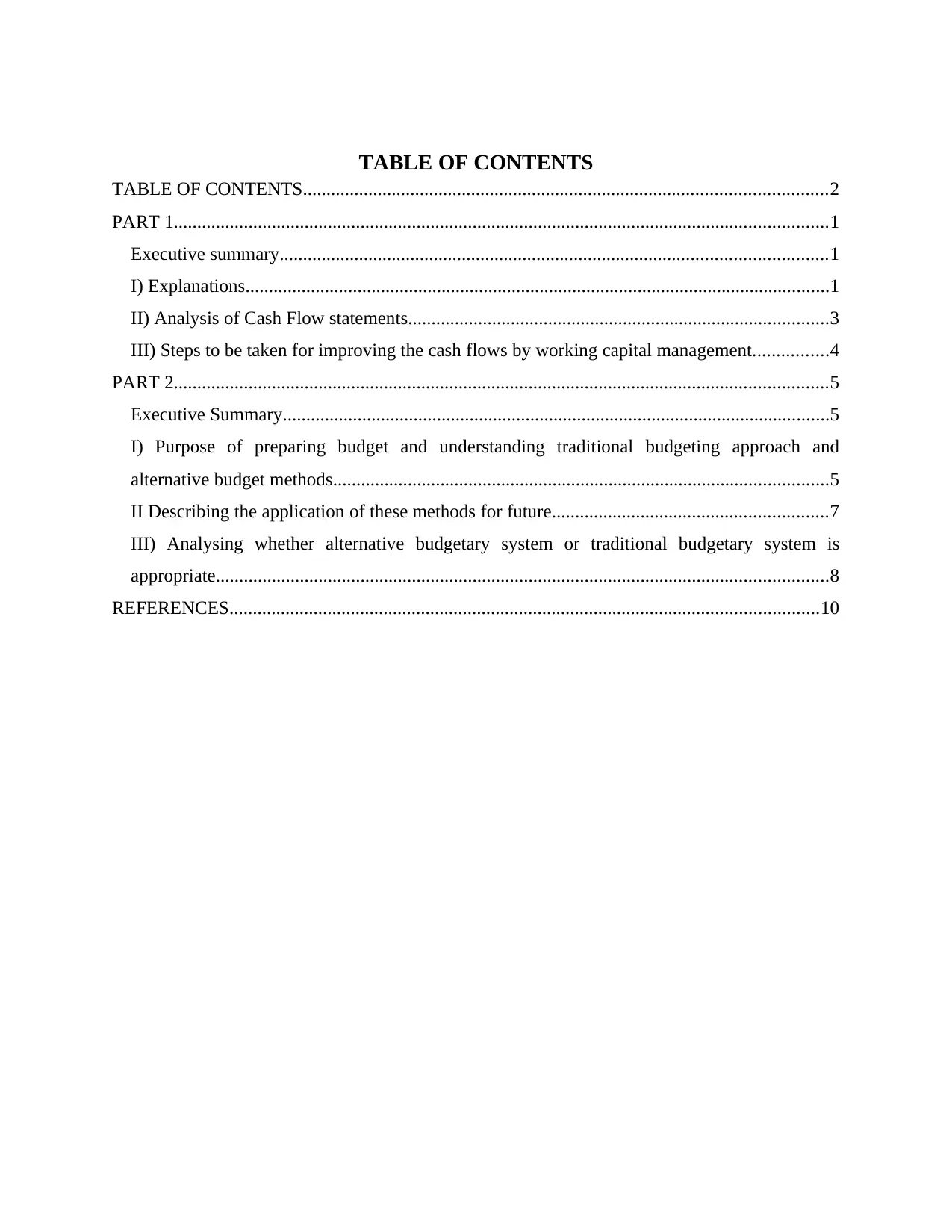
TABLE OF CONTENTS
TABLE OF CONTENTS................................................................................................................2
PART 1............................................................................................................................................1
Executive summary.....................................................................................................................1
I) Explanations.............................................................................................................................1
II) Analysis of Cash Flow statements..........................................................................................3
III) Steps to be taken for improving the cash flows by working capital management................4
PART 2............................................................................................................................................5
Executive Summary.....................................................................................................................5
I) Purpose of preparing budget and understanding traditional budgeting approach and
alternative budget methods..........................................................................................................5
II Describing the application of these methods for future...........................................................7
III) Analysing whether alternative budgetary system or traditional budgetary system is
appropriate...................................................................................................................................8
REFERENCES..............................................................................................................................10
TABLE OF CONTENTS................................................................................................................2
PART 1............................................................................................................................................1
Executive summary.....................................................................................................................1
I) Explanations.............................................................................................................................1
II) Analysis of Cash Flow statements..........................................................................................3
III) Steps to be taken for improving the cash flows by working capital management................4
PART 2............................................................................................................................................5
Executive Summary.....................................................................................................................5
I) Purpose of preparing budget and understanding traditional budgeting approach and
alternative budget methods..........................................................................................................5
II Describing the application of these methods for future...........................................................7
III) Analysing whether alternative budgetary system or traditional budgetary system is
appropriate...................................................................................................................................8
REFERENCES..............................................................................................................................10

PART 1
Executive summary
This part reveals the importance of cash flows and the profits. They help in determining how
cash flows could be negative even when the company is showing profits. There are various cases
where the profitability is shown. Working capital of the company could be used for managing
the cash flows and how they impact the cash flows. It will also recommend steps that could be
used for improving the cash flows.
Report to the shareholders
I) Explanations
a) Profit and Cash Flows and how they are different
Profits
Profits of a company describes financial benefits realized when revenues generated from
business activities exceeds costs, expenses and taxes that are involved in sustaining activity.
Profits earned by the business funnel back to its owners , who have the choice of using this profit
for their own benefits or to reinvest back into business. Profits are calculated as total revenues
less total expense. Profits refers to the money pulled by the business after all the expenses have
been accounted. Be it a sole proprietary business or a multinational company primary goal of
every business is of earning money, therefore performance of the business is measured based on
its profitability. Profits are of three types gross profits, operating profits and net profits and all of
these are shown in income statement of company (Williams and Dobelman, J.A., 2017). Every
profit gives different type of information that are used by the analysts according to their needs.
Cash Flow
Cash flow refers to the amount of net cash & cash equivalent that are being transferred in
and out of business. At basic fundamental level, cash flows determine the ability of company to
generate positive cash flows and create values for its shareholders. It is also aimed at maximising
the long term cash flows. Assessing amounts, timings and uncertainty in cash flows is also the
objective of financial reporting. For assessing the flexibility, liquidity and financial performance
of the company it is essential to have an understanding of the cash flows(Miao, Teoh and Zhu,
2016). Cash flows are important for recognising whether the company is utilising the cash funds
in an efficient manner or not.
1
Executive summary
This part reveals the importance of cash flows and the profits. They help in determining how
cash flows could be negative even when the company is showing profits. There are various cases
where the profitability is shown. Working capital of the company could be used for managing
the cash flows and how they impact the cash flows. It will also recommend steps that could be
used for improving the cash flows.
Report to the shareholders
I) Explanations
a) Profit and Cash Flows and how they are different
Profits
Profits of a company describes financial benefits realized when revenues generated from
business activities exceeds costs, expenses and taxes that are involved in sustaining activity.
Profits earned by the business funnel back to its owners , who have the choice of using this profit
for their own benefits or to reinvest back into business. Profits are calculated as total revenues
less total expense. Profits refers to the money pulled by the business after all the expenses have
been accounted. Be it a sole proprietary business or a multinational company primary goal of
every business is of earning money, therefore performance of the business is measured based on
its profitability. Profits are of three types gross profits, operating profits and net profits and all of
these are shown in income statement of company (Williams and Dobelman, J.A., 2017). Every
profit gives different type of information that are used by the analysts according to their needs.
Cash Flow
Cash flow refers to the amount of net cash & cash equivalent that are being transferred in
and out of business. At basic fundamental level, cash flows determine the ability of company to
generate positive cash flows and create values for its shareholders. It is also aimed at maximising
the long term cash flows. Assessing amounts, timings and uncertainty in cash flows is also the
objective of financial reporting. For assessing the flexibility, liquidity and financial performance
of the company it is essential to have an understanding of the cash flows(Miao, Teoh and Zhu,
2016). Cash flows are important for recognising whether the company is utilising the cash funds
in an efficient manner or not.
1
⊘ This is a preview!⊘
Do you want full access?
Subscribe today to unlock all pages.

Trusted by 1+ million students worldwide
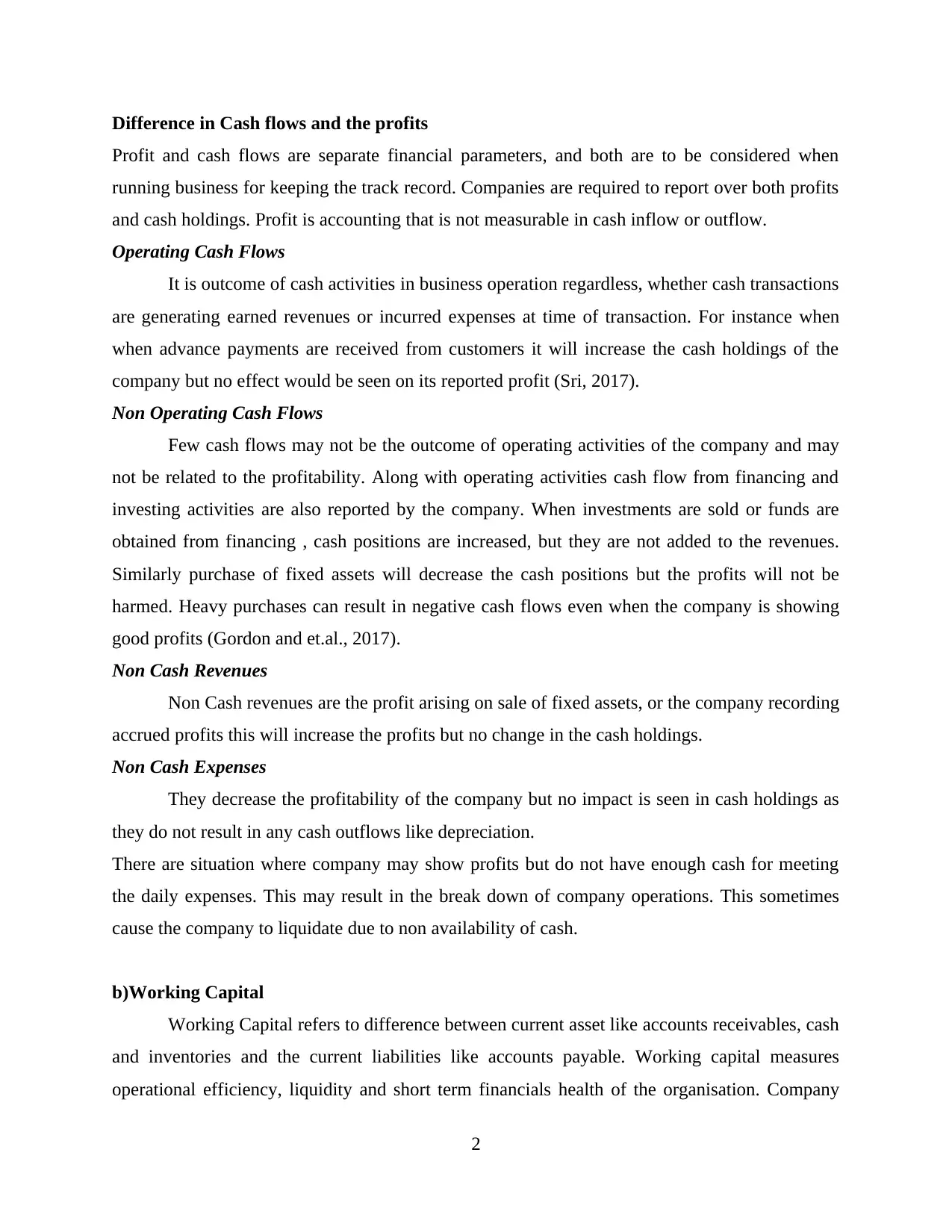
Difference in Cash flows and the profits
Profit and cash flows are separate financial parameters, and both are to be considered when
running business for keeping the track record. Companies are required to report over both profits
and cash holdings. Profit is accounting that is not measurable in cash inflow or outflow.
Operating Cash Flows
It is outcome of cash activities in business operation regardless, whether cash transactions
are generating earned revenues or incurred expenses at time of transaction. For instance when
when advance payments are received from customers it will increase the cash holdings of the
company but no effect would be seen on its reported profit (Sri, 2017).
Non Operating Cash Flows
Few cash flows may not be the outcome of operating activities of the company and may
not be related to the profitability. Along with operating activities cash flow from financing and
investing activities are also reported by the company. When investments are sold or funds are
obtained from financing , cash positions are increased, but they are not added to the revenues.
Similarly purchase of fixed assets will decrease the cash positions but the profits will not be
harmed. Heavy purchases can result in negative cash flows even when the company is showing
good profits (Gordon and et.al., 2017).
Non Cash Revenues
Non Cash revenues are the profit arising on sale of fixed assets, or the company recording
accrued profits this will increase the profits but no change in the cash holdings.
Non Cash Expenses
They decrease the profitability of the company but no impact is seen in cash holdings as
they do not result in any cash outflows like depreciation.
There are situation where company may show profits but do not have enough cash for meeting
the daily expenses. This may result in the break down of company operations. This sometimes
cause the company to liquidate due to non availability of cash.
b)Working Capital
Working Capital refers to difference between current asset like accounts receivables, cash
and inventories and the current liabilities like accounts payable. Working capital measures
operational efficiency, liquidity and short term financials health of the organisation. Company
2
Profit and cash flows are separate financial parameters, and both are to be considered when
running business for keeping the track record. Companies are required to report over both profits
and cash holdings. Profit is accounting that is not measurable in cash inflow or outflow.
Operating Cash Flows
It is outcome of cash activities in business operation regardless, whether cash transactions
are generating earned revenues or incurred expenses at time of transaction. For instance when
when advance payments are received from customers it will increase the cash holdings of the
company but no effect would be seen on its reported profit (Sri, 2017).
Non Operating Cash Flows
Few cash flows may not be the outcome of operating activities of the company and may
not be related to the profitability. Along with operating activities cash flow from financing and
investing activities are also reported by the company. When investments are sold or funds are
obtained from financing , cash positions are increased, but they are not added to the revenues.
Similarly purchase of fixed assets will decrease the cash positions but the profits will not be
harmed. Heavy purchases can result in negative cash flows even when the company is showing
good profits (Gordon and et.al., 2017).
Non Cash Revenues
Non Cash revenues are the profit arising on sale of fixed assets, or the company recording
accrued profits this will increase the profits but no change in the cash holdings.
Non Cash Expenses
They decrease the profitability of the company but no impact is seen in cash holdings as
they do not result in any cash outflows like depreciation.
There are situation where company may show profits but do not have enough cash for meeting
the daily expenses. This may result in the break down of company operations. This sometimes
cause the company to liquidate due to non availability of cash.
b)Working Capital
Working Capital refers to difference between current asset like accounts receivables, cash
and inventories and the current liabilities like accounts payable. Working capital measures
operational efficiency, liquidity and short term financials health of the organisation. Company
2
Paraphrase This Document
Need a fresh take? Get an instant paraphrase of this document with our AI Paraphraser
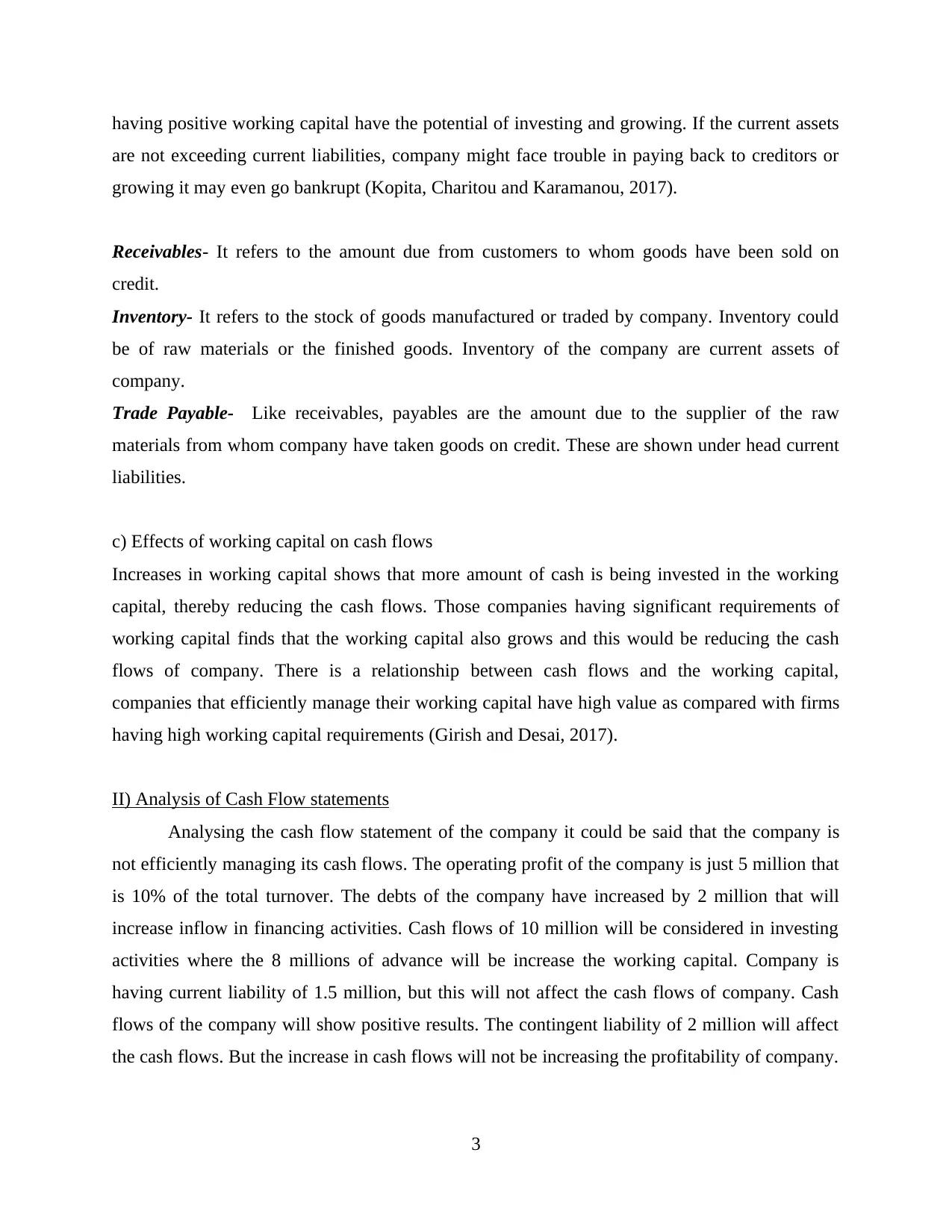
having positive working capital have the potential of investing and growing. If the current assets
are not exceeding current liabilities, company might face trouble in paying back to creditors or
growing it may even go bankrupt (Kopita, Charitou and Karamanou, 2017).
Receivables- It refers to the amount due from customers to whom goods have been sold on
credit.
Inventory- It refers to the stock of goods manufactured or traded by company. Inventory could
be of raw materials or the finished goods. Inventory of the company are current assets of
company.
Trade Payable- Like receivables, payables are the amount due to the supplier of the raw
materials from whom company have taken goods on credit. These are shown under head current
liabilities.
c) Effects of working capital on cash flows
Increases in working capital shows that more amount of cash is being invested in the working
capital, thereby reducing the cash flows. Those companies having significant requirements of
working capital finds that the working capital also grows and this would be reducing the cash
flows of company. There is a relationship between cash flows and the working capital,
companies that efficiently manage their working capital have high value as compared with firms
having high working capital requirements (Girish and Desai, 2017).
II) Analysis of Cash Flow statements
Analysing the cash flow statement of the company it could be said that the company is
not efficiently managing its cash flows. The operating profit of the company is just 5 million that
is 10% of the total turnover. The debts of the company have increased by 2 million that will
increase inflow in financing activities. Cash flows of 10 million will be considered in investing
activities where the 8 millions of advance will be increase the working capital. Company is
having current liability of 1.5 million, but this will not affect the cash flows of company. Cash
flows of the company will show positive results. The contingent liability of 2 million will affect
the cash flows. But the increase in cash flows will not be increasing the profitability of company.
3
are not exceeding current liabilities, company might face trouble in paying back to creditors or
growing it may even go bankrupt (Kopita, Charitou and Karamanou, 2017).
Receivables- It refers to the amount due from customers to whom goods have been sold on
credit.
Inventory- It refers to the stock of goods manufactured or traded by company. Inventory could
be of raw materials or the finished goods. Inventory of the company are current assets of
company.
Trade Payable- Like receivables, payables are the amount due to the supplier of the raw
materials from whom company have taken goods on credit. These are shown under head current
liabilities.
c) Effects of working capital on cash flows
Increases in working capital shows that more amount of cash is being invested in the working
capital, thereby reducing the cash flows. Those companies having significant requirements of
working capital finds that the working capital also grows and this would be reducing the cash
flows of company. There is a relationship between cash flows and the working capital,
companies that efficiently manage their working capital have high value as compared with firms
having high working capital requirements (Girish and Desai, 2017).
II) Analysis of Cash Flow statements
Analysing the cash flow statement of the company it could be said that the company is
not efficiently managing its cash flows. The operating profit of the company is just 5 million that
is 10% of the total turnover. The debts of the company have increased by 2 million that will
increase inflow in financing activities. Cash flows of 10 million will be considered in investing
activities where the 8 millions of advance will be increase the working capital. Company is
having current liability of 1.5 million, but this will not affect the cash flows of company. Cash
flows of the company will show positive results. The contingent liability of 2 million will affect
the cash flows. But the increase in cash flows will not be increasing the profitability of company.
3

Therefore it is essential to effectively manage the cash flows and working capital of the company
(Ketz, 2016).
III) Steps to be taken for improving the cash flows by working capital management.
Working capital means amount through which current asset of company exceeds the current
liabilities. Cash flows of the company could be improved by effectively managing the working
capital of company. Here the company is growing at constant pace with sufficient profits than
also the company may face negative cash flows. Therefore it is essential for company to manage
properly its cash flows.
Cash flows could be improved by managing the working capital.
Improving the Inventory
VLE should conduct inventory checks over short periods so that goods that are not moving at
same pace like other goods are identified. Company should offer more discounts for selling the
products that will increase the turnover and cash inflow to the company. It should not store
inventory that is unnecessary occupying space (Mathuva, 2015).
Trade Receivables
VLE should check the credibility of customers before selling goods to customer on credit.
Charge interest on delay over the specified limit in credit days. Reduce the credit days for
rotation of the cash flows.
Trade Payables
For the suppliers VLE should maintain friendly relations with them. This will help in bargaining
better trading terms. Ask for discounts from suppliers on early payments for the purchases.
Raising long term loans
Company for carrying out the working capital requirements should go for long term loans instead
of short term loans this will decrease the current liabilities of company (Aktas, Croci. and
Petmezas, 2015).
4
(Ketz, 2016).
III) Steps to be taken for improving the cash flows by working capital management.
Working capital means amount through which current asset of company exceeds the current
liabilities. Cash flows of the company could be improved by effectively managing the working
capital of company. Here the company is growing at constant pace with sufficient profits than
also the company may face negative cash flows. Therefore it is essential for company to manage
properly its cash flows.
Cash flows could be improved by managing the working capital.
Improving the Inventory
VLE should conduct inventory checks over short periods so that goods that are not moving at
same pace like other goods are identified. Company should offer more discounts for selling the
products that will increase the turnover and cash inflow to the company. It should not store
inventory that is unnecessary occupying space (Mathuva, 2015).
Trade Receivables
VLE should check the credibility of customers before selling goods to customer on credit.
Charge interest on delay over the specified limit in credit days. Reduce the credit days for
rotation of the cash flows.
Trade Payables
For the suppliers VLE should maintain friendly relations with them. This will help in bargaining
better trading terms. Ask for discounts from suppliers on early payments for the purchases.
Raising long term loans
Company for carrying out the working capital requirements should go for long term loans instead
of short term loans this will decrease the current liabilities of company (Aktas, Croci. and
Petmezas, 2015).
4
⊘ This is a preview!⊘
Do you want full access?
Subscribe today to unlock all pages.

Trusted by 1+ million students worldwide
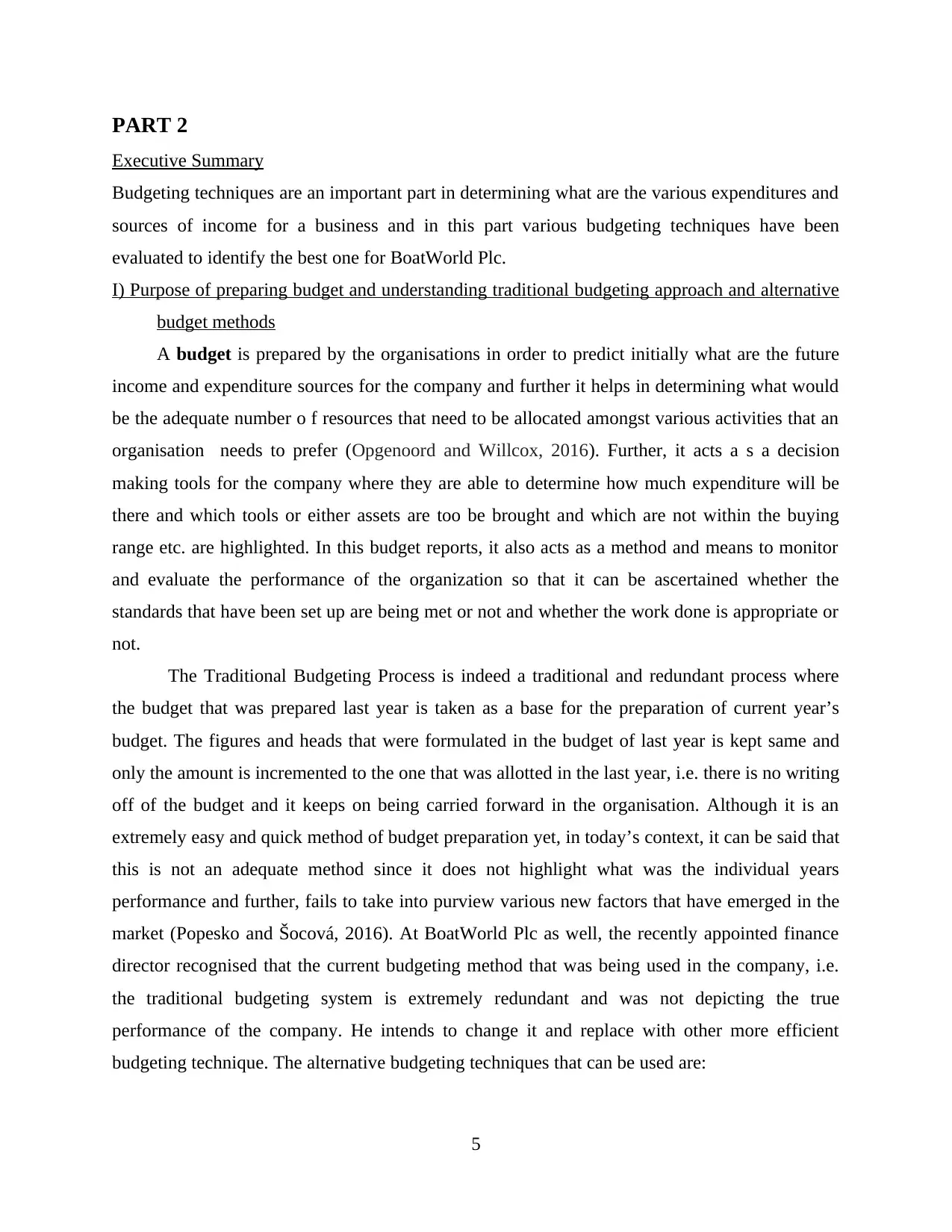
PART 2
Executive Summary
Budgeting techniques are an important part in determining what are the various expenditures and
sources of income for a business and in this part various budgeting techniques have been
evaluated to identify the best one for BoatWorld Plc.
I) Purpose of preparing budget and understanding traditional budgeting approach and alternative
budget methods
A budget is prepared by the organisations in order to predict initially what are the future
income and expenditure sources for the company and further it helps in determining what would
be the adequate number o f resources that need to be allocated amongst various activities that an
organisation needs to prefer (Opgenoord and Willcox, 2016). Further, it acts a s a decision
making tools for the company where they are able to determine how much expenditure will be
there and which tools or either assets are too be brought and which are not within the buying
range etc. are highlighted. In this budget reports, it also acts as a method and means to monitor
and evaluate the performance of the organization so that it can be ascertained whether the
standards that have been set up are being met or not and whether the work done is appropriate or
not.
The Traditional Budgeting Process is indeed a traditional and redundant process where
the budget that was prepared last year is taken as a base for the preparation of current year’s
budget. The figures and heads that were formulated in the budget of last year is kept same and
only the amount is incremented to the one that was allotted in the last year, i.e. there is no writing
off of the budget and it keeps on being carried forward in the organisation. Although it is an
extremely easy and quick method of budget preparation yet, in today’s context, it can be said that
this is not an adequate method since it does not highlight what was the individual years
performance and further, fails to take into purview various new factors that have emerged in the
market (Popesko and Šocová, 2016). At BoatWorld Plc as well, the recently appointed finance
director recognised that the current budgeting method that was being used in the company, i.e.
the traditional budgeting system is extremely redundant and was not depicting the true
performance of the company. He intends to change it and replace with other more efficient
budgeting technique. The alternative budgeting techniques that can be used are:
5
Executive Summary
Budgeting techniques are an important part in determining what are the various expenditures and
sources of income for a business and in this part various budgeting techniques have been
evaluated to identify the best one for BoatWorld Plc.
I) Purpose of preparing budget and understanding traditional budgeting approach and alternative
budget methods
A budget is prepared by the organisations in order to predict initially what are the future
income and expenditure sources for the company and further it helps in determining what would
be the adequate number o f resources that need to be allocated amongst various activities that an
organisation needs to prefer (Opgenoord and Willcox, 2016). Further, it acts a s a decision
making tools for the company where they are able to determine how much expenditure will be
there and which tools or either assets are too be brought and which are not within the buying
range etc. are highlighted. In this budget reports, it also acts as a method and means to monitor
and evaluate the performance of the organization so that it can be ascertained whether the
standards that have been set up are being met or not and whether the work done is appropriate or
not.
The Traditional Budgeting Process is indeed a traditional and redundant process where
the budget that was prepared last year is taken as a base for the preparation of current year’s
budget. The figures and heads that were formulated in the budget of last year is kept same and
only the amount is incremented to the one that was allotted in the last year, i.e. there is no writing
off of the budget and it keeps on being carried forward in the organisation. Although it is an
extremely easy and quick method of budget preparation yet, in today’s context, it can be said that
this is not an adequate method since it does not highlight what was the individual years
performance and further, fails to take into purview various new factors that have emerged in the
market (Popesko and Šocová, 2016). At BoatWorld Plc as well, the recently appointed finance
director recognised that the current budgeting method that was being used in the company, i.e.
the traditional budgeting system is extremely redundant and was not depicting the true
performance of the company. He intends to change it and replace with other more efficient
budgeting technique. The alternative budgeting techniques that can be used are:
5
Paraphrase This Document
Need a fresh take? Get an instant paraphrase of this document with our AI Paraphraser

Rolling Budgets: This budget, which is more appropriate for managers of small business, gives
the flexibility of reviewing the budget not on an yearly basis but on a quarterly or monthly basis
since it takes into account the factor that market might change within one year. Therefore this
budget is prepared not just once in a year but as per the convenience of the business manager.
Advantages Disadvantages
It helps in developing a more logical and
reasonable expenditure source and helps in
incorporating changes more quick with the
changing trends in the business environment.
It is an extremely time consuming and
expensive process that leaves a manager with
less time to focus on actual business activities
and thus affect the profitability and operation
of business.
Zero Based Budgets: Under this, for every new year or period, the budget is prepared form a
start and zero base is take as a base i.e. it does not builds up on the budget of last year (Szűcsné
Markovics, 2016). This is the best budgeting method to replace the traditional budgeting in
BoatWorld Plc
Advantages Disadvantages
It helps in including only those items in the
budget that are legit and justified i.e. n
unnecessary or those items that have become
redundant in the current day are used.
This kind of budgets might not provide an
adequate budget for resources that will give
long term benefits such as research and
development since it is prepared only for a
year.
Activity Based Budgets: In this kind of budget, again the past year’s budget is not taken in to
consideration and rather a new budget is prepared based on the analysis of those activities that
are incurring cost in the organisation, i.e. activity based costing.
Advantages Disadvantages
It helps in gaining competitive edge and treats
business as a single unit thus improving the
evaluation of the performance. Further it also
helps in removing bottlenecks since only
rewarding activities are included in the budget.
It is a complex process and requires deep
understanding of each and every activity that is
being performed in the business. Further, it is a
costly and time consuming process.
6
the flexibility of reviewing the budget not on an yearly basis but on a quarterly or monthly basis
since it takes into account the factor that market might change within one year. Therefore this
budget is prepared not just once in a year but as per the convenience of the business manager.
Advantages Disadvantages
It helps in developing a more logical and
reasonable expenditure source and helps in
incorporating changes more quick with the
changing trends in the business environment.
It is an extremely time consuming and
expensive process that leaves a manager with
less time to focus on actual business activities
and thus affect the profitability and operation
of business.
Zero Based Budgets: Under this, for every new year or period, the budget is prepared form a
start and zero base is take as a base i.e. it does not builds up on the budget of last year (Szűcsné
Markovics, 2016). This is the best budgeting method to replace the traditional budgeting in
BoatWorld Plc
Advantages Disadvantages
It helps in including only those items in the
budget that are legit and justified i.e. n
unnecessary or those items that have become
redundant in the current day are used.
This kind of budgets might not provide an
adequate budget for resources that will give
long term benefits such as research and
development since it is prepared only for a
year.
Activity Based Budgets: In this kind of budget, again the past year’s budget is not taken in to
consideration and rather a new budget is prepared based on the analysis of those activities that
are incurring cost in the organisation, i.e. activity based costing.
Advantages Disadvantages
It helps in gaining competitive edge and treats
business as a single unit thus improving the
evaluation of the performance. Further it also
helps in removing bottlenecks since only
rewarding activities are included in the budget.
It is a complex process and requires deep
understanding of each and every activity that is
being performed in the business. Further, it is a
costly and time consuming process.
6
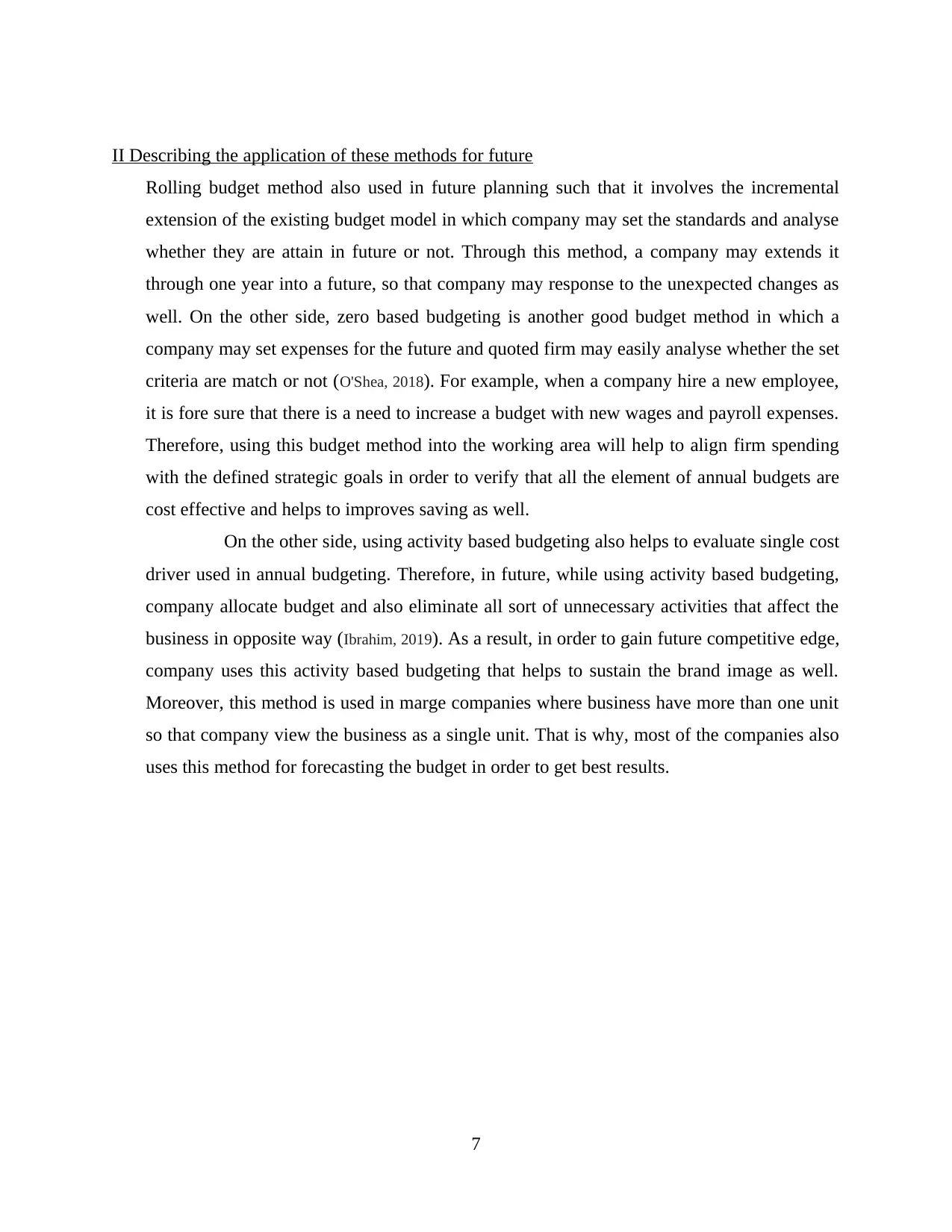
II Describing the application of these methods for future
Rolling budget method also used in future planning such that it involves the incremental
extension of the existing budget model in which company may set the standards and analyse
whether they are attain in future or not. Through this method, a company may extends it
through one year into a future, so that company may response to the unexpected changes as
well. On the other side, zero based budgeting is another good budget method in which a
company may set expenses for the future and quoted firm may easily analyse whether the set
criteria are match or not (O'Shea, 2018). For example, when a company hire a new employee,
it is fore sure that there is a need to increase a budget with new wages and payroll expenses.
Therefore, using this budget method into the working area will help to align firm spending
with the defined strategic goals in order to verify that all the element of annual budgets are
cost effective and helps to improves saving as well.
On the other side, using activity based budgeting also helps to evaluate single cost
driver used in annual budgeting. Therefore, in future, while using activity based budgeting,
company allocate budget and also eliminate all sort of unnecessary activities that affect the
business in opposite way (Ibrahim, 2019). As a result, in order to gain future competitive edge,
company uses this activity based budgeting that helps to sustain the brand image as well.
Moreover, this method is used in marge companies where business have more than one unit
so that company view the business as a single unit. That is why, most of the companies also
uses this method for forecasting the budget in order to get best results.
7
Rolling budget method also used in future planning such that it involves the incremental
extension of the existing budget model in which company may set the standards and analyse
whether they are attain in future or not. Through this method, a company may extends it
through one year into a future, so that company may response to the unexpected changes as
well. On the other side, zero based budgeting is another good budget method in which a
company may set expenses for the future and quoted firm may easily analyse whether the set
criteria are match or not (O'Shea, 2018). For example, when a company hire a new employee,
it is fore sure that there is a need to increase a budget with new wages and payroll expenses.
Therefore, using this budget method into the working area will help to align firm spending
with the defined strategic goals in order to verify that all the element of annual budgets are
cost effective and helps to improves saving as well.
On the other side, using activity based budgeting also helps to evaluate single cost
driver used in annual budgeting. Therefore, in future, while using activity based budgeting,
company allocate budget and also eliminate all sort of unnecessary activities that affect the
business in opposite way (Ibrahim, 2019). As a result, in order to gain future competitive edge,
company uses this activity based budgeting that helps to sustain the brand image as well.
Moreover, this method is used in marge companies where business have more than one unit
so that company view the business as a single unit. That is why, most of the companies also
uses this method for forecasting the budget in order to get best results.
7
⊘ This is a preview!⊘
Do you want full access?
Subscribe today to unlock all pages.

Trusted by 1+ million students worldwide
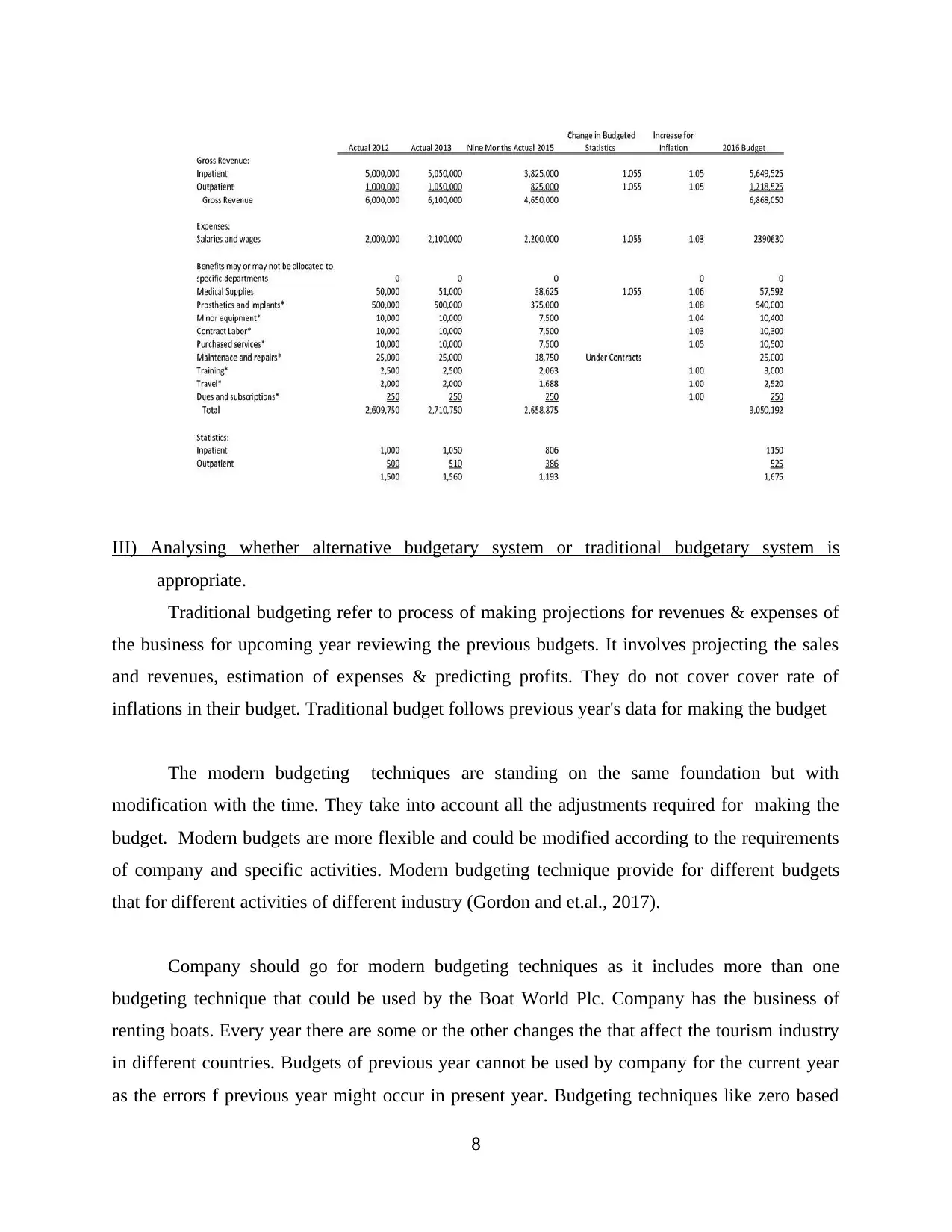
III) Analysing whether alternative budgetary system or traditional budgetary system is
appropriate.
Traditional budgeting refer to process of making projections for revenues & expenses of
the business for upcoming year reviewing the previous budgets. It involves projecting the sales
and revenues, estimation of expenses & predicting profits. They do not cover cover rate of
inflations in their budget. Traditional budget follows previous year's data for making the budget
The modern budgeting techniques are standing on the same foundation but with
modification with the time. They take into account all the adjustments required for making the
budget. Modern budgets are more flexible and could be modified according to the requirements
of company and specific activities. Modern budgeting technique provide for different budgets
that for different activities of different industry (Gordon and et.al., 2017).
Company should go for modern budgeting techniques as it includes more than one
budgeting technique that could be used by the Boat World Plc. Company has the business of
renting boats. Every year there are some or the other changes the that affect the tourism industry
in different countries. Budgets of previous year cannot be used by company for the current year
as the errors f previous year might occur in present year. Budgeting techniques like zero based
8
appropriate.
Traditional budgeting refer to process of making projections for revenues & expenses of
the business for upcoming year reviewing the previous budgets. It involves projecting the sales
and revenues, estimation of expenses & predicting profits. They do not cover cover rate of
inflations in their budget. Traditional budget follows previous year's data for making the budget
The modern budgeting techniques are standing on the same foundation but with
modification with the time. They take into account all the adjustments required for making the
budget. Modern budgets are more flexible and could be modified according to the requirements
of company and specific activities. Modern budgeting technique provide for different budgets
that for different activities of different industry (Gordon and et.al., 2017).
Company should go for modern budgeting techniques as it includes more than one
budgeting technique that could be used by the Boat World Plc. Company has the business of
renting boats. Every year there are some or the other changes the that affect the tourism industry
in different countries. Budgets of previous year cannot be used by company for the current year
as the errors f previous year might occur in present year. Budgeting techniques like zero based
8
Paraphrase This Document
Need a fresh take? Get an instant paraphrase of this document with our AI Paraphraser
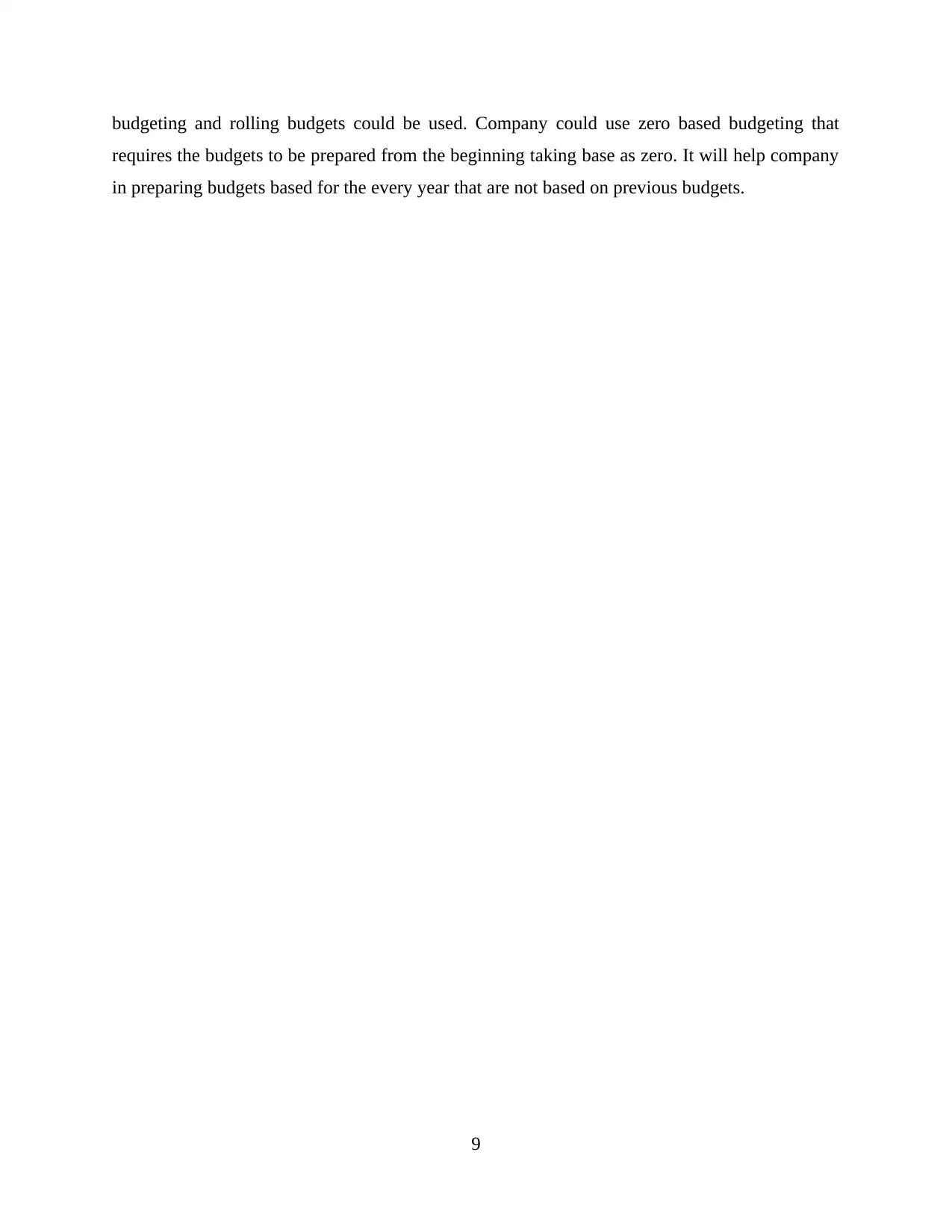
budgeting and rolling budgets could be used. Company could use zero based budgeting that
requires the budgets to be prepared from the beginning taking base as zero. It will help company
in preparing budgets based for the every year that are not based on previous budgets.
9
requires the budgets to be prepared from the beginning taking base as zero. It will help company
in preparing budgets based for the every year that are not based on previous budgets.
9
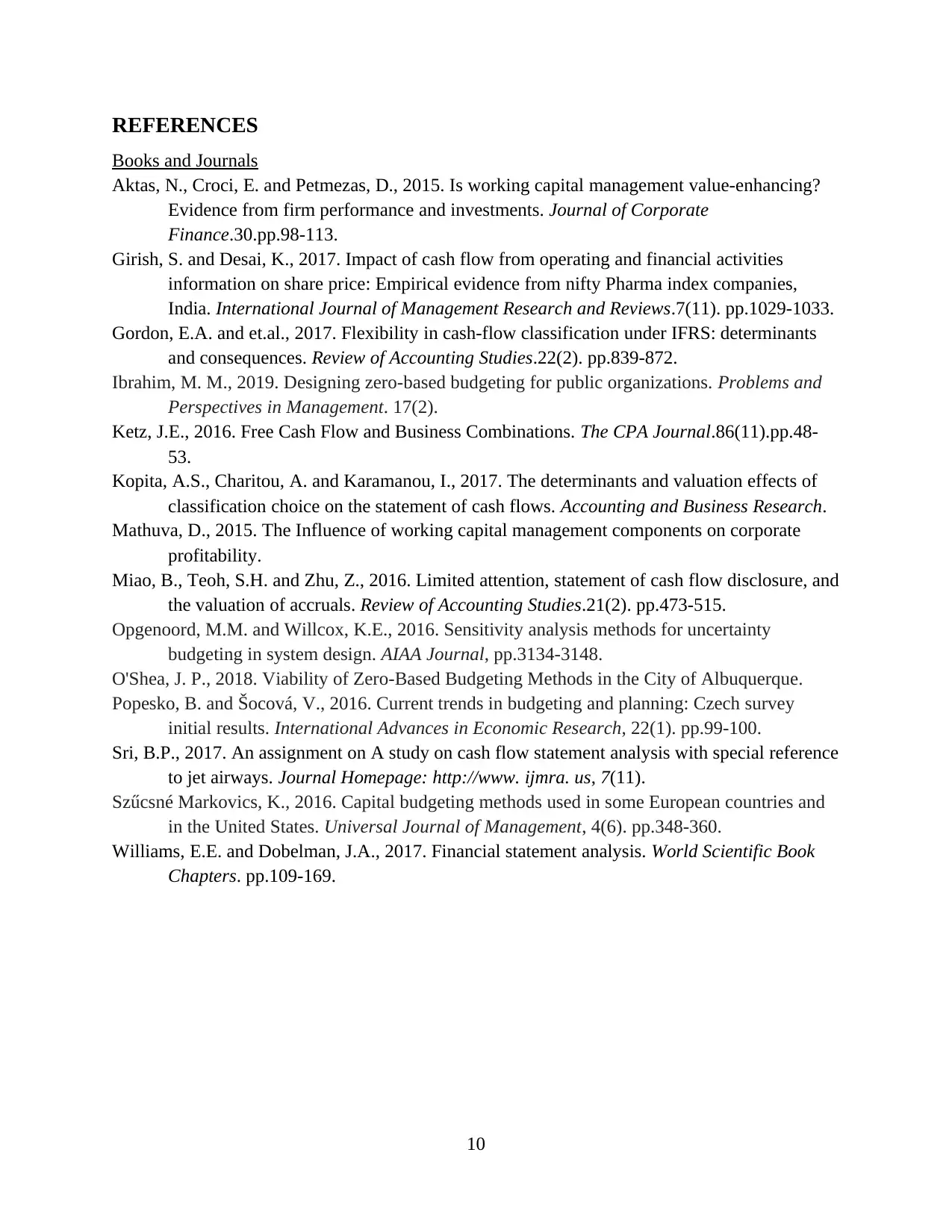
REFERENCES
Books and Journals
Aktas, N., Croci, E. and Petmezas, D., 2015. Is working capital management value-enhancing?
Evidence from firm performance and investments. Journal of Corporate
Finance.30.pp.98-113.
Girish, S. and Desai, K., 2017. Impact of cash flow from operating and financial activities
information on share price: Empirical evidence from nifty Pharma index companies,
India. International Journal of Management Research and Reviews.7(11). pp.1029-1033.
Gordon, E.A. and et.al., 2017. Flexibility in cash-flow classification under IFRS: determinants
and consequences. Review of Accounting Studies.22(2). pp.839-872.
Ibrahim, M. M., 2019. Designing zero-based budgeting for public organizations. Problems and
Perspectives in Management. 17(2).
Ketz, J.E., 2016. Free Cash Flow and Business Combinations. The CPA Journal.86(11).pp.48-
53.
Kopita, A.S., Charitou, A. and Karamanou, I., 2017. The determinants and valuation effects of
classification choice on the statement of cash flows. Accounting and Business Research.
Mathuva, D., 2015. The Influence of working capital management components on corporate
profitability.
Miao, B., Teoh, S.H. and Zhu, Z., 2016. Limited attention, statement of cash flow disclosure, and
the valuation of accruals. Review of Accounting Studies.21(2). pp.473-515.
Opgenoord, M.M. and Willcox, K.E., 2016. Sensitivity analysis methods for uncertainty
budgeting in system design. AIAA Journal, pp.3134-3148.
O'Shea, J. P., 2018. Viability of Zero-Based Budgeting Methods in the City of Albuquerque.
Popesko, B. and Šocová, V., 2016. Current trends in budgeting and planning: Czech survey
initial results. International Advances in Economic Research, 22(1). pp.99-100.
Sri, B.P., 2017. An assignment on A study on cash flow statement analysis with special reference
to jet airways. Journal Homepage: http://www. ijmra. us, 7(11).
Szűcsné Markovics, K., 2016. Capital budgeting methods used in some European countries and
in the United States. Universal Journal of Management, 4(6). pp.348-360.
Williams, E.E. and Dobelman, J.A., 2017. Financial statement analysis. World Scientific Book
Chapters. pp.109-169.
10
Books and Journals
Aktas, N., Croci, E. and Petmezas, D., 2015. Is working capital management value-enhancing?
Evidence from firm performance and investments. Journal of Corporate
Finance.30.pp.98-113.
Girish, S. and Desai, K., 2017. Impact of cash flow from operating and financial activities
information on share price: Empirical evidence from nifty Pharma index companies,
India. International Journal of Management Research and Reviews.7(11). pp.1029-1033.
Gordon, E.A. and et.al., 2017. Flexibility in cash-flow classification under IFRS: determinants
and consequences. Review of Accounting Studies.22(2). pp.839-872.
Ibrahim, M. M., 2019. Designing zero-based budgeting for public organizations. Problems and
Perspectives in Management. 17(2).
Ketz, J.E., 2016. Free Cash Flow and Business Combinations. The CPA Journal.86(11).pp.48-
53.
Kopita, A.S., Charitou, A. and Karamanou, I., 2017. The determinants and valuation effects of
classification choice on the statement of cash flows. Accounting and Business Research.
Mathuva, D., 2015. The Influence of working capital management components on corporate
profitability.
Miao, B., Teoh, S.H. and Zhu, Z., 2016. Limited attention, statement of cash flow disclosure, and
the valuation of accruals. Review of Accounting Studies.21(2). pp.473-515.
Opgenoord, M.M. and Willcox, K.E., 2016. Sensitivity analysis methods for uncertainty
budgeting in system design. AIAA Journal, pp.3134-3148.
O'Shea, J. P., 2018. Viability of Zero-Based Budgeting Methods in the City of Albuquerque.
Popesko, B. and Šocová, V., 2016. Current trends in budgeting and planning: Czech survey
initial results. International Advances in Economic Research, 22(1). pp.99-100.
Sri, B.P., 2017. An assignment on A study on cash flow statement analysis with special reference
to jet airways. Journal Homepage: http://www. ijmra. us, 7(11).
Szűcsné Markovics, K., 2016. Capital budgeting methods used in some European countries and
in the United States. Universal Journal of Management, 4(6). pp.348-360.
Williams, E.E. and Dobelman, J.A., 2017. Financial statement analysis. World Scientific Book
Chapters. pp.109-169.
10
⊘ This is a preview!⊘
Do you want full access?
Subscribe today to unlock all pages.

Trusted by 1+ million students worldwide
1 out of 12
Related Documents
Your All-in-One AI-Powered Toolkit for Academic Success.
+13062052269
info@desklib.com
Available 24*7 on WhatsApp / Email
![[object Object]](/_next/static/media/star-bottom.7253800d.svg)
Unlock your academic potential
Copyright © 2020–2025 A2Z Services. All Rights Reserved. Developed and managed by ZUCOL.





